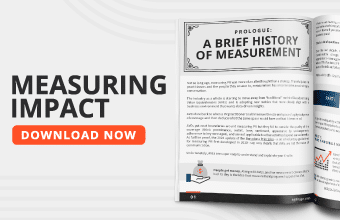As a PR professional, the saying “knowledge is power” likely rings very true, especially for anyone who’s seen a big campaign go down in flames.
When late hours and big bucks add up to a whole lot of nothing, it’s easy to get discouraged. Especially when your boss is looking for those magic numbers that prove their decision to invest company dollars in your campaign was worth it. They’re looking for the return on investment (ROI). But the truth is, wins and losses hold equal value in forming your strategy — and the better you become at evaluating your efforts, at learning from your mistakes and your successes, the more literate you’ll be in the art of successful PR campaigns, and the more you’ll be able to offer your executive teams the evidence they’re looking for.
So, to aid you in your quest for boss-pleasing, successful PR campaigns, we’ve outlined three steps for evaluating your performance. Using measurements to benchmark will not only help you prove your ROI, but also ensure that your campaigns and activities are consistently reaching new heights.
Before we move forward it’s really important to point out that ROI is often thought of strictly in the sense of quantitative value. AKA Numbers, numbers, and more numbers! And while data-driven goals and analysis are crucial to any successful campaign, that doesn’t mean we can forget about the qualitative side of ROI. Think, establishing thought leadership, building trust with target audiences, nurturing relationships, and helping to educate customers. Slightly more difficult to measure objectively, but crucial nonetheless.
Both qualitative and quantitative lenses need to be applied when considering ROI, and with that in mind, have a look at some of our suggestions:
STEP 1: Get a Grip on Historical Coverage
It’s pretty tricky to prove ROI on your campaigns without first getting a solid grasp of where your campaigns stand now, and where they’ve stood in the past when it comes to key metrics.
A great starting point – look at mentions of your brand and your competitors or industry in the last three months and get a report of:
- Coverage over time – number of mentions
- Share of Voice – your brand’s exposure and conversation with target audiences versus your competitors
- Sentiment – how many positive or negative mentions
This look-back sheds light on journalists or publications who are advocates (or detractors), provides insight on why your stories got picked up (or not) and much more. In other words, it’s the foundation you need before you can start tying your efforts to business objectives and really owning the coverage game.
Be sure to work with your media monitoring solutions provider to get the most out of your analysis (and make your life easier!). Companies like Agility PR Solutions have self-service and full-service monitoring solutions that can track all mentions of your brand and generate reports for you. We can even work with you to devise a custom media quality scoring system to quantify how valuable an article or mention is to your organization.
STEP 2: Go Beyond the Numbers
Now that you have quantified your coverage, you need to look at how effective that coverage was. Did you reach your target audience or inspire them to engage or act?
Business Matters magazine says that measuring the volume of coverage is not necessarily indicative of success: “The true purpose of any PR campaign is to communicate influentially to the target audience in order to get them to act, behave or think in a different way than before and improve stakeholder relationships… if the media coverage does not result in the target audience actually acting on the call to action in the PR communications campaign then this raises the question has it really been effective?”
Which means it’s time to start digging into the impact of coverage. You can do that in a few ways:
- Primary research i.e. a survey to find out how customers or prospects heard about you
- Look for correlations between coverage and business objectives like sales, stock price, or fundraising. Were there changes in web traffic, sales or stock price that happened after specific efforts or campaigns?
- Look at website analytics. If you had a URL in outreach materials, get access to Google Analytics or whatever you use to track your site traffic and determine where visitors to that page came from. Check if they visited multiple pages afterwards or if they left quickly after arriving (bounce rate). Dive into social media impact. Think about different metrics you can measure and what it means to your organization: views = audience, followers = target audience reach, and comments/shares = engagement. Focus on conversations and instances in which you got people interested. What strategies or opportunities did you overlook (or overestimate)? Clues will almost certainly be there.
STEP 3: Use This Information To Set Goals
Ranking yourself against the competition is important — but you also need to see how you measure against yourself. This is the importance of benchmarking.
Start setting reasonable expectations and establish key performance indicators (KPIs) for campaigns based on your findings. For example: we want X featured articles, a press release should generate an X% increase in web traffic, we want to increase our media quality score by X points, etc.
Use the SMART model to determine your campaign objectives and make sure they are:
- Specific
- Measurable
- Attainable
- Relevant
- Timely
This gives you a grading system to see if you are, in fact, improving. You can use a mix of hard (quantitative) and soft evidence (qualitative research, observation, and anecdotal evidence) to determine whether your efforts have been a success, and if not, use the data to help determine a new plan for next time.
Conducting reviews during and after the campaign should become part of your process moving forward and will ultimately bring you closer to knocking it out of the park on a regular basis.
Thorough PR measurement isn’t always easy, but it has the power to make you look like a superstar so we’re inclined to say it’s worth investing time and resources in. And if you pick a good partner to work with, you’ll have help every step of the way.
Let us show you how.







